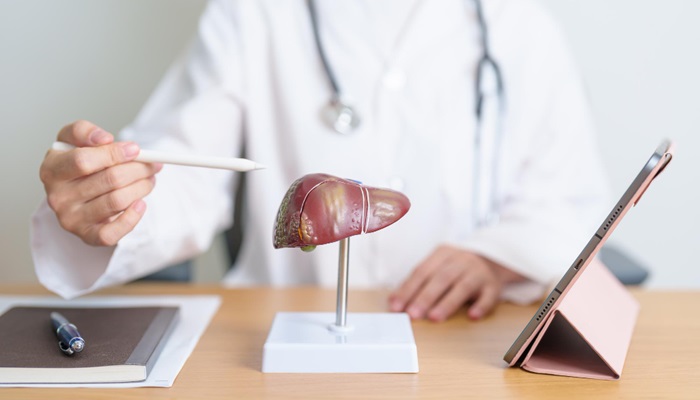A liver biopsy is a medical procedure used to assess liver health by taking a small tissue sample, which is then examined under a microscope for abnormalities. While it may seem like a surgical procedure, a liver biopsy can be done on an outpatient basis.
Contents
What is a Liver Biopsy?
A liver biopsy is a procedure where a small piece of liver tissue is removed for laboratory examination. This process is carried out using a hollow needle to collect the tissue sample.
There are three types of liver biopsy methods:
- Percutaneous Liver Biopsy: Performed through a small incision in the abdominal area.
- Transjugular Liver Biopsy: Conducted through a vein.
- Surgical Biopsy: Performed via open surgery or laparoscopy.
Purpose of a Liver Biopsy
A liver biopsy is conducted for several reasons, including:
- Diagnosing liver diseases that cannot be detected through blood tests or imaging alone.
- Determining the stage or severity of liver disease.
- Identifying appropriate treatments for liver damage or disease.
- Examining abnormal tissue or lesions found in imaging tests.
Common conditions diagnosed with a liver biopsy include:
- Hepatitis
- Fatty liver disease
- Liver tumors
- Liver fibrosis
- Metabolic autoimmune diseases
- Liver cancer
- Cirrhosis
When is a Liver Biopsy Needed?
A liver biopsy is usually recommended if you exhibit symptoms of liver disease and laboratory or imaging tests (such as ultrasound, CT scan, or MRI) fail to provide a definitive diagnosis.
Doctors may suggest a liver biopsy if you experience:
- Enlarged liver
- Jaundice (yellowing of the skin and eyes)
- Abnormal liver function test results
Liver Biopsy Procedure
A liver biopsy does not always require general anesthesia, depending on the type of biopsy performed. General anesthesia is necessary for surgical or laparoscopic biopsies, while percutaneous and transjugular biopsies may only require mild sedation.
Before the biopsy, your doctor will conduct preliminary tests to ensure you are fit for the procedure.
Percutaneous Liver Biopsy
This biopsy involves inserting a thin, hollow needle through a small incision in the upper abdomen. Steps of the procedure:
- The doctor locates the biopsy site by tapping on the abdomen or using ultrasound/CT scan.
- Local anesthesia is applied, and mild sedation may be given for comfort.
- You will be asked to lie on your back with your right arm positioned over your head.
- A small incision is made on the right side of the abdomen, and the biopsy needle is inserted.
- You may be asked to hold your breath while the liver sample is taken.
- After the biopsy, the incision is covered with a bandage, and you will need to lie on your right side for a few hours.
- The doctor will monitor you for 2-4 hours before allowing you to go home.
Transjugular Liver Biopsy
This procedure is performed through the jugular vein in the neck. Steps of the procedure:
- You will lie down while the doctor identifies the right position in the neck to access the jugular vein.
- Ultrasound or fluoroscopy is used to locate the appropriate vein between the neck and liver.
- Local anesthesia is applied to the neck, and the biopsy needle is inserted.
- A small incision is made to insert a catheter with a biopsy needle into the vein leading to the liver.
- The tissue sample is collected through the catheter.
- After the biopsy, you will need to rest for 2-4 hours before being discharged.
Surgical Liver Biopsy
This can be performed as open surgery or laparoscopy (a minimally invasive procedure requiring a small incision). Steps of the procedure:
- You will be positioned on the operating table.
- General anesthesia is administered.
- For laparoscopy, a small incision is made in the abdomen to insert a laparoscope (a device with a camera) to guide the doctor in collecting the tissue sample.
- For open surgery, a larger incision is made to access the liver directly.
A percutaneous liver biopsy typically takes about 15-30 minutes, while a transjugular liver biopsy may take 30-60 minutes.
In most cases, a liver biopsy is done on an outpatient basis. However, you may need to stay in the hospital for 2-4 hours for monitoring before being discharged.
It is advisable to avoid heavy lifting for about a week after the procedure. You can resume normal activities fully after a year.
Risks of a Liver Biopsy
A liver biopsy is generally a safe and simple procedure. However, as with any medical procedure, there are potential risks, including:
- Internal bleeding
- Pain at the incision site
- Infection
- Temporary facial nerve issues
- Temporary voice problems
- Damage to nearby organs
- Bile leakage
- Low blood pressure
Liver Biopsy Results
The results of a liver biopsy are typically available within a few days. To interpret the findings, you will need to consult a liver specialist who can provide a diagnosis, determine the disease stage, and plan the appropriate treatment.
If you experience liver disease symptoms, consult an internal medicine specialist with expertise in gastroenterology and hepatology.
You can visit the Mandaya Liver Center at Mandaya Royal Hospital Group to meet with top hepatology doctors. Contact us via WhatsApp chat, book an appointment, or download the Care Doctor app from Google Play and the App Store to schedule a consultation.



